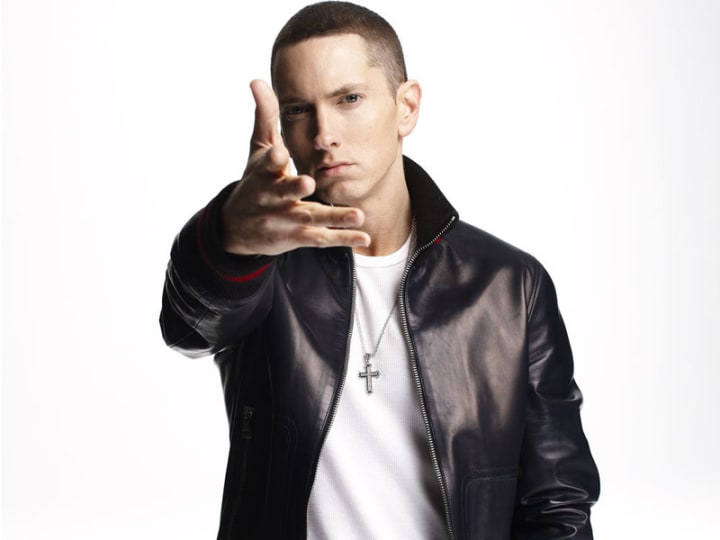Eminem's Street Cred of Personas
Why Eminem Is Allowed to Rap in the Perspective of a White Police Officer

Eminem is one of the most well respected rappers of the 21st Century. He has sold over 100 million albums worldwide (Shady Records). He is known for being a voice of reason of the rap scene and providing not just laughs and tears from his songs but also contemplative theses. In his 2017 album Revival, he displays his thesis of racial equality in his song “Untouchable.” He does this by beginning from a Caucasian police officer’s point of view to draw attention and then ending by rapping his beliefs on what the nation can do to change the disfunction. But why can he, a Caucasian male, release a song at that level of complexity and sensitivity? It is because of his reputation, being the first famous Caucasian to write a song in favor of the Black Lives Matter movement, and his lyrics are full of references and power.
Marshall Mathers III was born in St. Joseph, Missouri on October 17th 1972. His father, Marshall Mathers Jr, abandoned his family and refused his son’s contact attempts throughout his childhood. Due to this, Mathers was mainly raised by his mother, Deborah Mathers. The family moved around frequently through Missouri and Detroit, Michigan because his mother was unable to hold a job for more than a few months at a time. He changed high schools two to three times a year, was constantly bullied and had no close friends which contributed to his aloof rough personality. He also publicly detailed his mother’s addiction of prescription drugs in his song lyrics as well as her physical and emotional abuse of him. However, she has strongly denied this and has even filed a defamation lawsuit of $10 million to her son. It was settled for $25,000. (Biography.com)
Mathers dropped out of Lincoln High School at the age of 17 but always had a closeness with language and even studied the dictionary. He brought this together with his talent of rapping to participate in rap battles held in the Detroit area. At this time, rap had been produced almost exclusively by African American people. Eminem, with his pale complexion and blue eyes, proved to be highly skilled in his craft and “became one of the most respected figures in Detroit's underground rap scene” (Biography.com). In 1995, he and his partner, Kim Ann Scott, had their daughter Hailie. In 1996, Eminem released his first independent album named Infinite. The low-budget record did not turn a profit and failed to catch broad public attention even though it displayed his verbal knowledge and power.
The next year, Mathers released The Slim Shady EP and was discovered by Dr. Dre, who signed him to his Interscope Records label. The Slim Shady LP was released in 1999 which became an instant success, selling over three million copies. These two records displayed one of Mathers’ three personas displayed in his music.
Slim Shady is his aggressive “devil on the shoulder of teenage rebels” (Time.com) persona that is known for having a dark sense of humor and violent tendencies. Slim Shady can be differenced from his other egos by his higher tone and elongated vowels. Shady welcomes controversy with open arms by writing about raping fifteen year olds and murdering his own father. He continues to grace Mathers’ current albums but his controversial content has been knocked down many notches since then.
In May of 2000, Mathers released The Marshall Mathers LP where his second ego was showcased. This ego shares the same name, Marshall Mathers. The Mathers ego is commented as being the artist’s true self and the songs being “really deep, meaningful and sad” (Quora.com). He comes out truly in his songs about his daughter such as "Mockingbird" and "Hailie’s Song." This ego is not differentiated by his voice usage but by his tempo as the songs are slower, softer, and somber. A common saying about Mathers’ egos are, “Slim Shady makes you laugh, Eminem makes you think, Marshall makes you cry…” (Quora.com).
The third and final ego, Eminem, is the introspective persona. “[He] calls out the bullshit he sees in the world,” Nick Jewison from Quora.com comments, “He ... has a lot of anger built up inside him” (Quora.com). His voice is differentiated from Slim Shady by being stressed in his chest and spitting out his lyrics quickly. He is displayed throughout Mathers’ work, specifically seen in “‘Til I Collapse” from the album The Eminem Show and “Stan” from The Marshall Mathers LP. Eminem is the “RapGod” Slim Shady wishes he could be.
Following the release of The Marshall Mathers LP, Mathers “recorded very little music and was largely consumed by personal problems” (Biography.com). Kim and him divorced in 2001 but had a dysfunctional on-and-off relationship until remarrying in 2006. They divorced again mere months later. Then began the highly public custody dispute over their daughter, Hailie. At the same time, Mathers was dealing with an addiction to sleeping pills and prescription painkillers along with alcoholism. In the December of 2007, he overdosed and almost died.
Recovery Promotional Photo

After grazing against death, Mathers dedicated himself to recording music again and released his albums Relapse and Recovery. The albums touched on his addiction and rehabilitation. The latter was seen as his most acclaimed in years and even won a Grammy Award for Best Rap Album in 2008. “[After] 10 years and seven albums, the rapper who shocked, appalled and fascinated the music world with the unbridled rage of his youthful music is reinventing himself as a mature artist,” said Biography.com. He then released The Marshall Mathers LP 2 in 2013 where he won the Best Rap/Sung Collaboration Grammy for his song with Rihanna “The Monster.”
Fast forward 3 years, Mathers released a freestyle rap against the United States President, Donald Trump, in October of 2017. He was not the first to fight against the governmental system, as it has been its own sub genre for decades, but there was an exponential spike in the years of 2013 to 2018. This all started with the Michael Brown shooting of August 2013. He was an eighteen year old African American male who was unarmed when he was fatally shot by a police officer. The officer claimed he was reaching for his gun but Brown’s friend that was with him denies the allegations. The following day, the candlelight vigil held for him turned violent with robberies of nearby businesses and injuries to officers.
What angered the people of Ferguson, Missouri was that officer Darren Wilson proclaimed the shooting in self defense. The trial held then confirmed this and let him walk free. There became a movement known as the #BlackLivesMatter campaign “whose mission is to build local power and to intervene in violence inflicted on Black communities by the state and vigilantes” (Black Lives Matter). This movement continued to shine as the voice to stand against injustice. Since Michael Brown, there have been many other wrongful fatal shootings such as Deravis Caine Rogers (AJC), Stephon Clark (The Guardian), Antwon Rose (USA Today) and more.
With the increase of violence, musical artists sought to bring people together for the cause. Some of the most notable were “Freedom” by Beyonce featuring Kendrick Lamar and J.Cole’s “Be Free” (Rolling Stone). However there was a pattern. There is a severe lack of Caucasian artists contributing to the movement. “When so many black musicians are using their platform to speak out in support of [the Black Lives Matter movement], the lack of white artists doing the same makes me uncomfortable,” says Mike Vinti from Norwich Radical. Eminem saw this and decided to make a change in his 2017 album Revival in a way no other rapper could.
Eminem Performing

The song begins with a barely audible intro of “Hands up, officer don’t shoot” which comes from the “Hands Up, Don’t Shoot” slogan made by the Michael Brown shooting. It is quickly retaliated with “then pull your pants up, promise you won’t loot” that motions to the “refrain among protesters opposing Black Lives Matter” (Genius). He then raps his first verse as Slim Shady in the mindset of a Caucasian Police Officer, calling out to an unnamed man as “Black Boy” as “whites used the word 'boy' to suggest that blacks were inferior and to assert their perceived dominance” (Genius). He continues to rap that the African American brings it upon himself with hiding cocaine, called Heidi Klum. Eminem then says, “And just in case a chase might ensue, we got that tried and true, pistol drew right at you, we'd be delighted to unload it” which is in reference to the 2015 shooting of Walter Scott (Genius). Scott fled from an officer in South Carolina and was shot in the back. Shady comes back by saying it is justified because he is “doing it for the best of his country” (Genius).
In the chorus, Eminem sings “white boy, you’re untouchable,” a connection to “where police continue to kill unarmed [African American] men in America with little consequence.” (Genius). He continues the second verse as Slim Shady with a reference to Freddie Grey’s unlawful arrest with “Throw your ass in the van cuffed.” Grey sustained injuries en route to the police station and died in a hospital a week after his arrest. Mathers continues the verse, calling out the police officers as “pigs” and “eyesores.” He then switches into his Eminem persona and ends the verse saying that the government system is drifting back into the 60s. “African-Americans have been treated like shit and I admit, there have been times where it's been embarrassin' to be a white boy,” he finishes and flows into the chorus, showing that his skin color has a bad connotation.
The third verse is then switched to the perspective of an African American man. He comments that it seems that Caucasians have twice as long of a life-span as an African American and how they struggle to find jobs that pay higher than minimum wage. He then says “as Dallas overshadows the battle for Black Lives Matter” which is in reference to the police officers that were ambushed and shot in Dallas, Texas at the end of a Black Lives Matter protest (Genius.com). Mathers brings to light that the fight is at a stalemate as each side keeps fighting with violence after violence. He then raps about how Caucasian officers are not used to African Americans and have only “seen some fuckin' videos of rappers waving guns” in their social media posts.
Eminem also brings up the question of “why are there black neighborhoods?” and says that it is because America has separated its people by designating places for low-income people to live. He makes note that the community only wants a safe place for their kids but the children cannot escape the fear of being chased down by an officer. He then talks about the different statistics that were made about how African American men not being trusted as much as Caucasian men. He adds that if you want to be safe in America, “You better be strapped with a derringer or be ‘capped in America’ like Steve Rogers” (Genius.com). Mathers brings his song to an end by calling out the whole nation on how it is called the “Land of the Free” but the people who built it were not free. They were slaves who were forced to build this country for free.
Eminem was not given backlash for this song because he has a strong past of reputation in rap music, is the first famous Caucasian artist to write for the Black Lives Matter movement, and he put his heart and knowledge into his lyrics. He has been a strong musical performer and his newest album Kamikaze shows that he is still a prominent figure in the music scene. His entire album brought back diss tracks to the genre. It caused more excitement when Machine Gun Kelly replied with his own diss track at Mathers. Eminem then replied with “Killshot” which shows he is not going to be leaving his listeners anytime soon. Although, he has stated before, “The truth is you don't know what is going to happen tomorrow. Life is a crazy ride, and nothing is guaranteed.”
About the Creator
Carol-Ann Gibbs
Your average music anime nerd






Comments
There are no comments for this story
Be the first to respond and start the conversation.